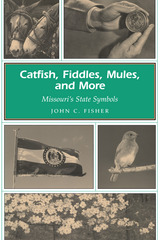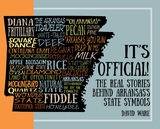3 books about Emblems, State

Catfish, Fiddles, Mules, and More
Missouri's State Symbols
John C. Fisher
University of Missouri Press, 2003
Throughout history symbols have been used in a variety of ways, often playing important roles. Each state has its own representative symbols—ranging from seals, flags, and buildings to rocks, minerals, plants, and animals—but how did they come to be chosen? In Catfish, Fiddles, Mules, and More, John C. Fisher provides an answer to that question for Missourians with a handy reference on the various official symbols of the state.
Fisher explores each of the symbols adopted by the legislature as well as the state nickname and the legislative process in Missouri. A chapter is devoted to each symbol, providing information about when it was adopted, why it came to be considered as a state symbol, and how it relates to and is representative of the state. For those symbols that are items of economic importance to the state, the nature of their contribution is also explained. In the case of animal and plant symbols, their biology and where they occur within the state is presented.
This important work, which includes thirty illustrations, will be helpful in acquainting Missourians and others interested in the state with not only the state’s symbols but the history of Missouri as well. Because the symbols were adopted over a long period of time, much of Missouri’s history has been included in the course of discussing them.
Thoroughly researched and well written, Catfish, Fiddles, Mules, and More fills a niche for this kind of information in a way no other work has done. It will be valuable to anyone with an interest in Missouri, and it will be particularly useful to elementary and high school students in their study of the state.
[more]

It's Official!
The Real Stories behind Arkansas’s State Symbols
David Ware
Butler Center for Arkansas Studies, 2015
Since Arkansas’s creation as an independent territory in 1819, its legislature has officially designated a wide assortment of symbols. Some of these refer to economic mainstays while others attest to the aspirations of those who saw a bright future for their extensive and varied community. This volume’s essays examine each of Arkansas’s officially designated symbols, outlining their genesis, their significance at the time of their adoption, and their place in modern Arkansas. Combining political narratives, natural history, and the occasional “shaggy dog” story, Ware makes a case for considering the symbols as useful keys to understanding both the Arkansas that has been and the one it hopes to be.
During the 2017 session, the Arkansas Legislative Assembly expanded the state’s complement of official state symbols. The second edition of this statewide bestseller includes an additional chapter on Arkansas’s newest symbol: the state dinosaur, Arkansaurus fridayi.
In It’s Official!, David Ware makes a case for considering the symbols as useful keys to understanding both the Arkansas that has been and the one it hopes to be.
[more]

Victory Banner Over the Reichstag
Film, Document and Ritual in Russia's Contested Memory of World War II
Jeremy Hicks
University of Pittsburgh Press, 2020
In one of the most iconic images from World War II, a Russian soldier raises a red flag atop the ruins of the German Reichstag on April 30, 1945. Known as the Victory Banner, this piece of fabric has come to symbolize Russian triumph, glory, and patriotism. Facsimiles are used in public celebrations all over the country, and an exact replica is the centerpiece in the annual Victory Parade in Moscow’s Red Square. The Victory Banner Over the Reichstag examines how and why this symbol was created, the changing media of its expression, and the contested evolution of its message. From association with Stalinism and communism to its acquisition of Russian nationalist meaning, Jeremy Hicks demonstrates how this symbol was used to construct a collective Russian memory of the war. He traces how the Soviets, and then Vladimir Putin, have used this image and the banner itself to build a remarkably powerful mythology of Russian greatness.
[more]
READERS
Browse our collection.
PUBLISHERS
See BiblioVault's publisher services.
STUDENT SERVICES
Files for college accessibility offices.
UChicago Accessibility Resources
home | accessibility | search | about | contact us
BiblioVault ® 2001 - 2024
The University of Chicago Press









